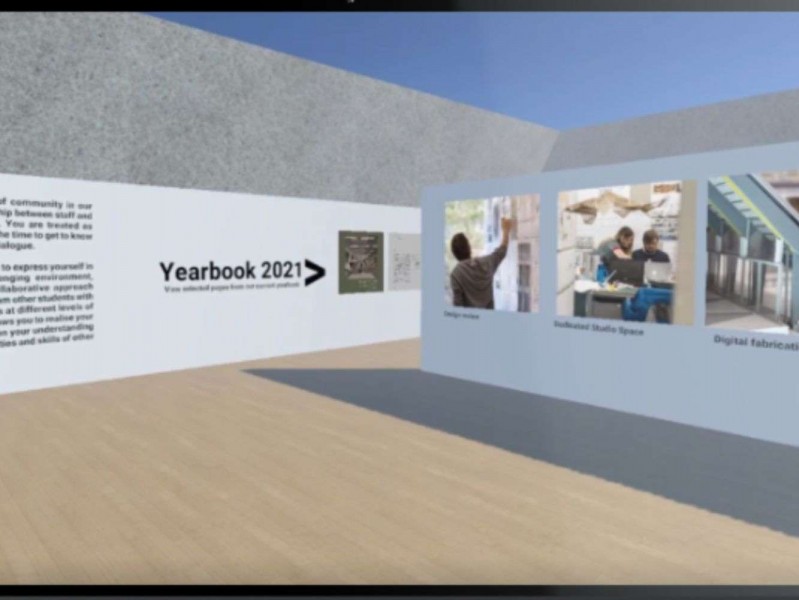Talent on show at The Scott Sutherland School Digital Exhibition 2021
Friday 17 September 2021

Visitors to The Scott Sutherland Digital Exhibition can immerse themselves in a dynamic virtual exhibition and explore a selection of exciting work from architecture students in years 1 – 3 and 5 – 6. The exhibition has been built by a team of students and lecturers at the school and showcases an imaginative range of work from the past year.
The exhibition highlights ‘The Living Fabric’ Masters project which builds upon last year’s ‘Living Edge’ proposals to improve Aberdeen’s beach front. Under the new plans, Aberdeen’s harbour waterfront area would be transformed. Industry would be moved to the south harbour development and new spaces, with key views and vistas, created for the public to enjoy the harbour’s edge. Entertainment, shopping and activities would replace industry and ‘green routes’ would link the city centre, beach and harbour front. A car free zone, dedicated to pedestrians and cyclists, would be built and a new auto tram network created along the route. More affordable housing, centred around a new village of St.Clements would encourage people to live in the city centre.
The exhibition also includes plans to improve the sustainability of Aberdeen’s King Street as one of the main routes leading out of the city centre. Under the Stage 5 plans, this congested city centre street, would be transformed into three 15-minute city zones. A better sense of community would be created to improve people’s well-being. An ‘Artisan’ zone, centred, around the arts centre, comedy club and performance venue, The Lemon Tree’ would be established. Another “University” section, would focus on education including Aberdeen University whilst the 3rd ‘Residential’ section, would celebrate the urban character of this north part of the site.
Head of the Scott Sutherland School of Architecture and Built Environment, Professor David McClean, said: ““The exhibition has been made possible thanks to the collaboration between students and a small team of lecturers over the summer. Visitors can explore a dynamic collection of imaginative work ranging from work to transform Aberdeen city centre to other projects in Orkney and the Western Isles.
"As one of the longest established schools of its kind in the UK, The Scott Sutherland School provides an outstanding grounding in architecture. As the work in this exhibition demonstrates, our students develop skills and techniques that equip them well for their future professional lives, and harness their creativity in the production of progressive ideas and proposals that are of value to the community.”
Thomas Storm, MSc Advanced architectural design student said: "I’ve really enjoyed contributing to Scott’s Digital Exhibition. It’s been a great experience that's given me a glimpse of the work undertaken throughout the whole year.
"I have just handed in my MSc thesis and really enjoyed my experience at RGU, including the new friendships I've made even during Covid-19. Scott’s really nurtures you as an individual and equips you with both the theoretical and practical skills necessary for a career in architecture.”
Other highlights from the show include designs for a zero-carbon hotel produced by first year students from the Architectural Technology course. The students create designs which embrace a healthy lifestyle, zero carbon footprint whilst also tackling the challenges of COVID-19. The group explored wind and solar energy sources and new material including timber, low carbon concrete and even algae in the design of the hotels. One student proposed a self-sufficient hotel with an urban farm whilst another designed a carbon neutral boutique hotel.
Elsewhere in the exhibition, visitors can explore projects from the Scott Sutherland School’s Orkney Unit. Stage 5 architecture students set out plans to build a sustainable green future in the Finstown area of ‘Mainland’, the biggest island of the Orkney Islands through a project known as ‘Pomono’, the ancient name for Orkney and re-imagine horticulture on the island. Stage 6, final year architecture students explore the sense of community in Kirkwall Centre. Another group explore Brinkies Brae in Stromness and propose reinstating Udal Law, where the strip of land from the sea to the top of the hill is divided in to five sections, to create a sustainable, community-based way of living.
Another project, the Seaweed Farm, proposes creating a new self-powering platform to cultivate, harvest and produce seaweed products. The project would create a new skilled industry for Stromness. A seaweed hatchery would cultivate seaweed which would be harvested off-shore before being transported to Hamnavoe Bay to dry naturally on a series of floating drying racks. It could then be transported back and processed at Stromness to produce a range of products including seaweed food, cosmetics, fertiliser and compost. The project would be self-powered using biogas created from biodegradable seaweed and using a water source heat pump.
The exhibition also showcases work from the Outer Hebrides Unit and explores ways of making the island more sustainable and tackles issues such as an aging demographic, housing shortage, economic challenges, climate change and suggests way to generate self-sufficiency and to improve food production and energy.
To find out more about The Scott Sutherland School register for the virtual RGU Open Day on Saturday 18 September and the on-campus open days on 2nd October and 30th November.
